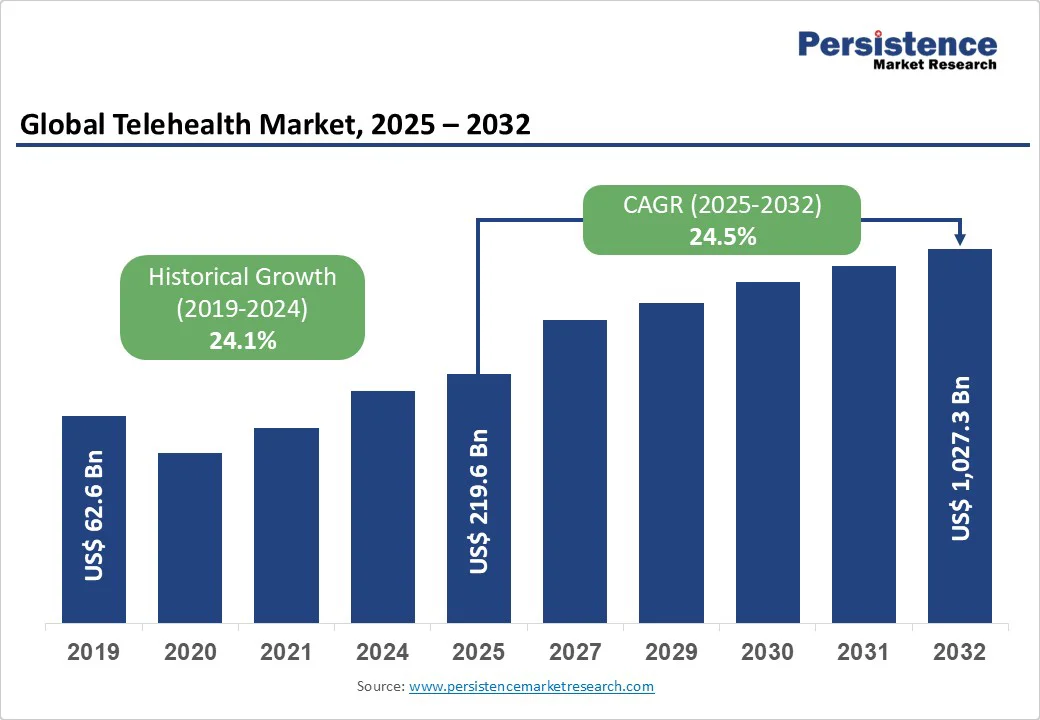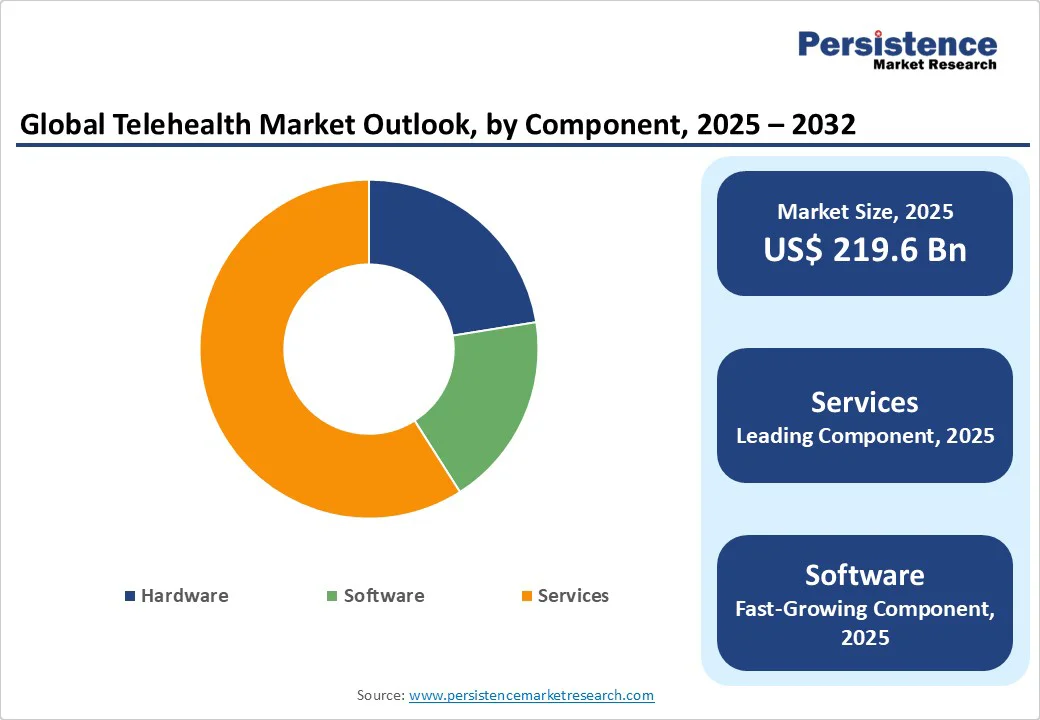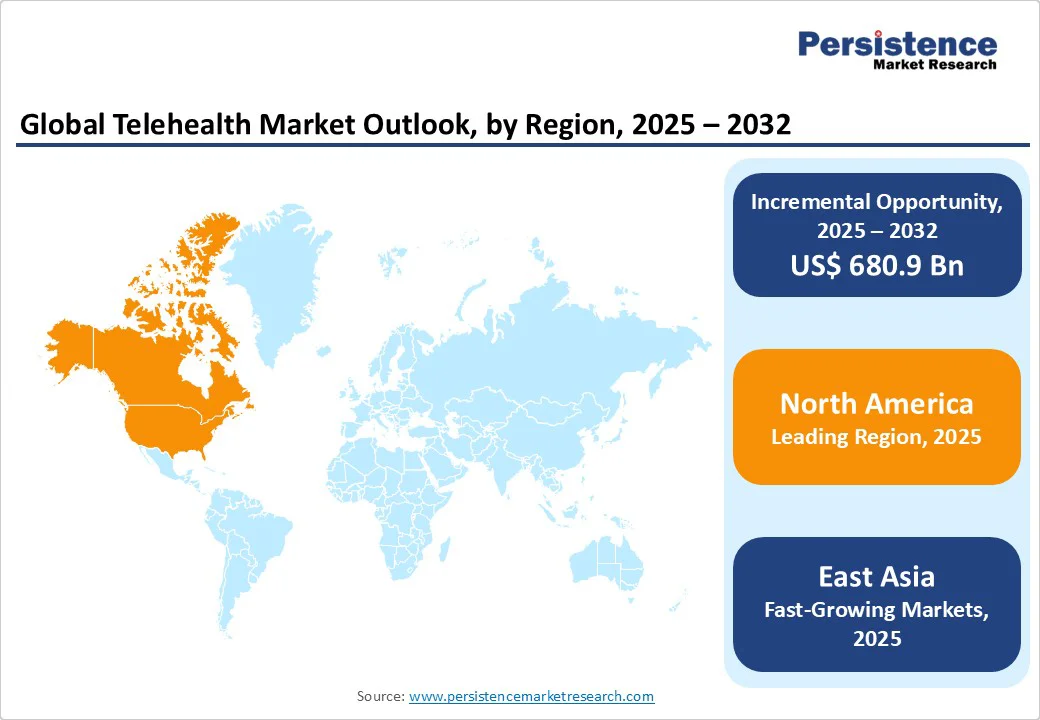ID: PMRREP34664| 188 Pages | 25 Sep 2025 | Format: PDF, Excel, PPT* | Healthcare

The global telehealth market size is expected to reach US$219.6 billion in 2025 and is projected to reach US$1,027.3 billion by 2032, growing at a CAGR of 24.5% during the forecast period from 2025 to 2032.
The global telehealth market is experiencing rapid growth, driven by increasing demand for accessible and cost-effective healthcare solutions.
| Key Insights | Details |
|---|---|
| Global Telehealth Market Size (2025E) | US$219.6 Bn |
| Market Value Forecast (2032F) | US$ 1,027.3 Bn |
| Projected Growth (CAGR 2025 to 2032) | 24.5% |
| Historical Market Growth (CAGR 2019 to 2024) | 24.1% |

Physicians' interest in continuing the use of telehealth remains strong, making it a significant driver for the technology's ongoing adoption in healthcare. According to studies by the American Medical Association (AMA), 85% of physicians are currently using telehealth, and nearly 70% report that their organizations are motivated to continue incorporating it into their practices.
This highlights the growing recognition of telehealth’s role in managing chronic diseases, coordinating care, and providing mental health services. Furthermore, physicians view telehealth as an essential tool for specialty care, ensuring greater access and convenience for both patients and providers.
Patients also exhibit a strong preference for telehealth, with surveys indicating high levels of satisfaction. In one of the largest studies examining telehealth during the COVID-19 pandemic, 79% of patients expressed being very satisfied with the care they received during their last telehealth visit, and 73% indicated they would continue using telehealth in the future.
Additionally, 41% of patients would have chosen telehealth over an in-person appointment, even if both required a copay. These findings suggest that telehealth is meeting patient needs and expectations, positioning it as a valuable long-term option in healthcare delivery.
Barriers to telehealth adoption persist, particularly related to coverage, payment, and reimbursement challenges. One significant issue is inconsistent coverage policies across different insurers, which makes it difficult for providers to offer telehealth services universally.
During the COVID-19 pandemic, temporary waivers expanded telehealth coverage, but the rollback of these waivers has created uncertainty about which services will remain covered. This inconsistency in coverage complicates access to telehealth for both patients and providers.
On the payment side, many insurers do not reimburse telehealth services at the same rate as in-person visits, or they may not reimburse them at all. This lack of reimbursement parity can undermine the financial viability of telehealth for healthcare providers, discouraging its use. Additionally, the reimbursement process for telehealth can be complex and time-consuming, with varying rules and requirements among different payers.
Some insurers are also reluctant to reimburse telehealth services, citing concerns about cost and potential overuse. These financial and administrative hurdles remain key obstacles to the widespread and sustainable adoption of telehealth in healthcare systems.
A crucial opportunity in addressing health inequities lies in building trust between healthcare organizations and the communities they serve. Historically, assumptions made by health organizations about community needs, without direct input, have eroded trust and perpetuated disparities.
To bridge this gap, organizations must engage communities meaningfully, listen to diverse perspectives, and incorporate consumer feedback into their strategies. Programs like the Health Equity Accreditation Plus initiative and Oscar's Culturally Competent Care Grant exemplify proactive efforts to meet patients' diverse social, cultural, and linguistic needs.
Establishing trust requires identifying and addressing the root causes of inequities, dismantling biases, and forming partnerships across sectors to target social determinants of health. By prioritizing transparency and inclusivity, healthcare providers can rebuild trust, enhance outcomes, and promote equitable access.
The services component dominates telehealth primarily because clinical and consultative offerings, such as remote patient monitoring, virtual visits, and tele-consultations, form the foundation of digital healthcare delivery. Without these services, hardware devices or platforms remain underutilized, as their real value lies in connecting patients with providers.
According to the CDC, in 2021, 80.5% of U.S. office-based physicians reported using telemedicine for patient care, a dramatic rise from just 16% in 2019. Similarly, about 37% of U.S. adults used telemedicine services within the past year, demonstrating widespread patient acceptance.
Additionally, CMS data indicate that over 12.6% of Medicare beneficiaries utilized telehealth services in Q4 2023. These statistics underscore why services dominate the telehealth market, driving adoption, outcomes, and sustained growth.
Web-based telehealth leads the market because it offers the most comprehensive and user-friendly mode of care delivery. Through secure online platforms, patients and providers can interact in real time using video, chat, and integrated health records, creating a seamless experience that telephone-only or device-based modes cannot match.
The flexibility of web-based systems allows easy integration with electronic health records, scheduling tools, and digital prescriptions, making it the preferred choice for hospitals and clinics. It also supports a wide range of services, from general consultations to specialist follow-ups and mental health software therapy. With growing digital literacy, improved broadband access, and supportive reimbursement frameworks, web-based platforms continue to dominate as the backbone of modern telehealth delivery.

Telehealth adoption in the U.S. surged dramatically during the COVID-19 pandemic and continues to shape healthcare delivery trends. According to the HHS, Medicare fee-for-service telehealth visits increased from approximately 840,000 in 2019 to 52.7 million in 2020, representing a 63-fold rise.
Although utilization declined after peak pandemic months, telehealth remains strongly embedded in the healthcare system. In 2024, approximately 25% of Medicare fee-for-service beneficiaries received at least one telehealth service, showing its ongoing role in care access.
Usage is particularly high among patients with chronic illnesses. A JAMA Network Open study revealed that 50% of adults with multiple chronic conditions relied on telemedicine compared to 33% without. Furthermore, nearly 46% of adult day service centers incorporated telehealth tools in 2022, with adoption especially strong in the Northeast and West regions.
Europe is a significant region in the telehealth market, accounting for a 26.8% share in 2025, primarily driven by the COVID-19 pandemic. Germany is the leading country, accounting for 26.4% of the regional market share in 2025. In the UK, NHS England data showed that the share of GP appointments conducted via digital means (telephone or video) rose from about 15% in January 2020 to 41% in January 2021, with figures remaining elevated thereafter.
Over half (58%) of NHS trusts reported using telemedicine technologies in some departments, including 41% for remote stroke care. According to WHO/Europe, 84% of countries now utilize teleradiology, 77% provide telemedicine or remote patient monitoring, and 51% offer telepsychiatry services. Interest in quality and regulatory frameworks is also growing, with the WHO launching the “Telehealth Quality of Care Tool” to guide the safe and high-quality implementation of telehealth across the region.
East Asia is emerging as the fastest-growing telehealth market, driven by large populations, strong government support, and rapid digital adoption. China is the leading country in the region, accounting for 46.2% of the market share in 2025.
In China, over 1,600 Internet hospitals are officially registered, integrating online consultations, prescriptions, and chronic disease management into mainstream care. By mid-2020, around 276 million people, nearly 30% of China’s internet users, had accessed online medical services, showing strong patient acceptance.
In India, the government’s eSanjeevani platform has recorded over 120 million cumulative consultations, often handling more than 90,000 visits per day, demonstrating the scalability of telehealth in rural and semi-urban areas. Healthcare professionals are also highly engaged, with 74% of Chinese healthcare providers using telemedicine on a weekly basis. Government initiatives, digital literacy, and healthcare access needs collectively explain the rapid growth of telehealth in East Asia.

The global telehealth market is highly competitive, led by players such as Teladoc Health, Amwell, and Doctor on Demand, alongside emerging startups in mental health and chronic care. Growth is driven by tech innovation, seamless integration, and data security. Companies focus on expanding services, enhancing user experience, and leveraging AI, wearables, and strategic partnerships to strengthen market presence.
The global telehealth market is projected to be valued at US$ 219.6 Bn in 2025.
Rising chronic diseases, technology adoption, smartphone penetration, healthcare accessibility, cost efficiency, aging population, and supportive government policies drive telehealth growth.
The global telehealth market is poised to witness a CAGR of 24.5% between 2025 and 2032.
Expanding rural access, AI integration, remote patient monitoring, mental health services, wearable devices, cross-border consultations, and personalized healthcare create telehealth opportunities.
Major players in the global telehealth market are Teladoc Health, Inc., Honeywell International Inc., Oracle Cerner, Siemens Healthineers, Medtronic, and others.
| Report Attribute | Details |
|---|---|
| Historical Data/Actuals | 2019 - 2024 |
| Forecast Period | 2025 - 2032 |
| Market Analysis | Value: US$ Bn |
| Geographical Coverage |
|
| Segmental Coverage |
|
| Competitive Analysis |
|
| Report Highlights |
|
By Component
By Mode of Action
By Application
By End User
By Region
Delivery Timelines
For more information on this report and its delivery timelines please get in touch with our sales team.
About Author